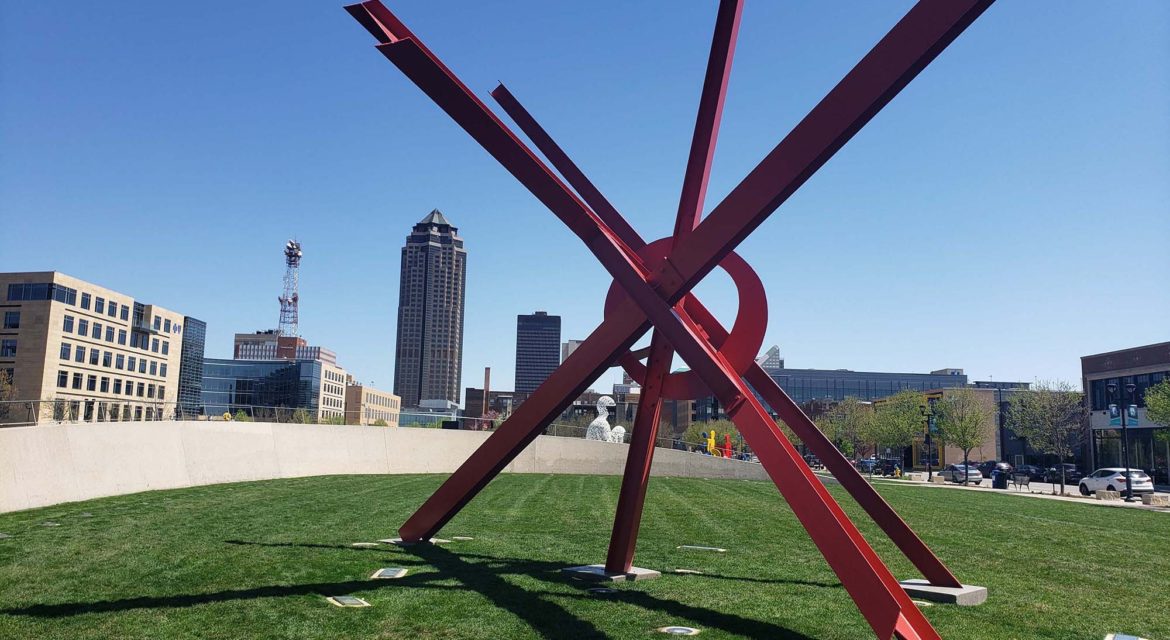 Sculpture parks across the world and even in Iowa have been able to create excitement and activity for entire communities, but few have done so with as much success as the John and Mary Pappajohn Sculpture Park. This collection of modern sculptures has helped to create a pedestrian-friendly entrance to downtown Des Moines, Iowa. In doing so, it has proven what it can mean for a sculpture park to transform the look and feel of an entire city and community.
Sculpture parks across the world and even in Iowa have been able to create excitement and activity for entire communities, but few have done so with as much success as the John and Mary Pappajohn Sculpture Park. This collection of modern sculptures has helped to create a pedestrian-friendly entrance to downtown Des Moines, Iowa. In doing so, it has proven what it can mean for a sculpture park to transform the look and feel of an entire city and community.

The Art of Our Time
 The John and Mary Pappajohn Sculpture Park features artwork by 24 of the world’s most celebrated artists. Named for the Des Moines venture capitalist and his wife, the sculptures are valued at more than $40 million and were given to the community through the Des Moines Art Center.
The John and Mary Pappajohn Sculpture Park features artwork by 24 of the world’s most celebrated artists. Named for the Des Moines venture capitalist and his wife, the sculptures are valued at more than $40 million and were given to the community through the Des Moines Art Center.
In 2007, John Pappajohn proposed that the space the city had acquired and cleared of dilapidated buildings between Grand Avenue and Locust Street on the western edge of downtown Des Moines be transitioned into a place that could house the Pappajohn’s sculpture collection. The effort to install the sculpture park ended up being a collaboration among the Pappajohns, other private donors, the city and the center. The effort allowed for the creation of a contemporary-art museum west of downtown.
Mark di Suvero’s “T8,” Richard Serra’s “Five Plate Pentagon,” Louise Bourgeois’ “Spider” and the “Moonrise” pieces by Ugo Rondinone are just a few of the most notable pieces in the sculpture park, but “Nomade”, by Spanish sculptor Jaume Plensa, is arguably the most famous of all the pieces in the park. The 27-foot-tall human form made of a latticework of steel letters is a monumental statue that is designed to be both inviting and embracing at the same time.
The variety of artists and styles featured at the John and Mary Pappajohn Sculpture Park is just one of the reasons that it has been able to have such a profound impact on the culture and economy of the entire city.

Connecting Des Moines
The John and Mary Pappajohn Sculpture Park was only one of the projects in a broad redevelopment of Des Moines’s downtown, but proved to be an important catalyst in the overall endeavor. The park has helped to spur the investment of more than $500 million in renovations along Locust and Grand, including the construction of the headquarters campuses of Wellmark Blue Cross and Blue Shield and Kum & Go Convenience Stores.
 With no admission charge, gate or fence, and operating hours that stretch from 6 a.m. to midnight, the sculpture park has allowed residents and visitors to have an intimate experience with all of the pieces in it, which is something that can change depending on when they’re there. Like other modern museum collections, the experience of being at the park during the day is very different from being there at night.
With no admission charge, gate or fence, and operating hours that stretch from 6 a.m. to midnight, the sculpture park has allowed residents and visitors to have an intimate experience with all of the pieces in it, which is something that can change depending on when they’re there. Like other modern museum collections, the experience of being at the park during the day is very different from being there at night.
In terms of the direct impacts it has made on and for the community, the park can be reserved for private events, and is also featured prominently in numerous maps and guides that highlight activities in downtown Des Moines. It has proven to attract both residents and visitors since they can do everything from have a picnic to go on an audio tour of the park to directly engage with pieces like Scott Burton’s Seating for Eight.
The John and Mary Pappajohn Sculpture Park has cultivated a sense of connection with and to the greater Des Moines community, and in doing so has created a monument that is more substantial than any single piece of sculpture in the park.

A Legacy of Freedom and Accessibility
 The number of sculptures in the John and Mary Pappajohn Sculpture Park continues to grow, which highlights the legacy the park has created for the greater Des Moines community. By further developing the sense of freedom and accessibility that the park was founded on, the impact to the cultural landscape and will become that more more more pronounced in the present and future.
The number of sculptures in the John and Mary Pappajohn Sculpture Park continues to grow, which highlights the legacy the park has created for the greater Des Moines community. By further developing the sense of freedom and accessibility that the park was founded on, the impact to the cultural landscape and will become that more more more pronounced in the present and future.

